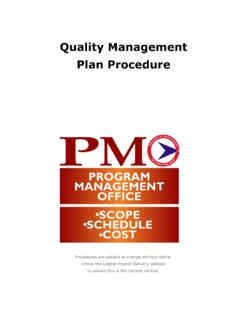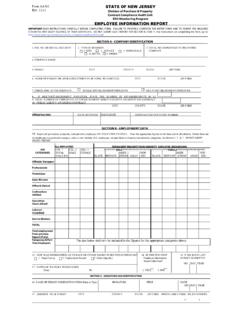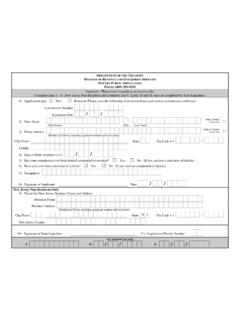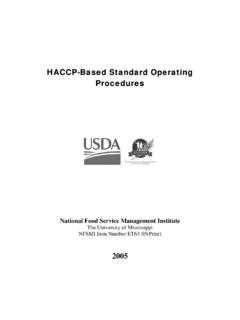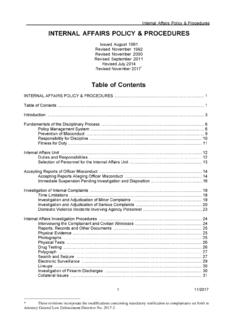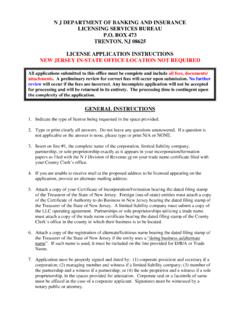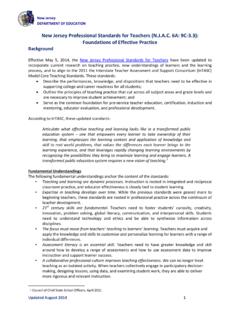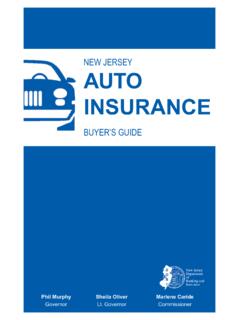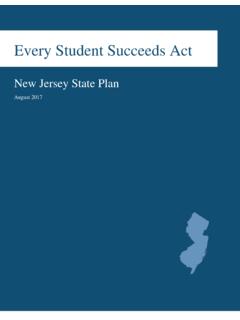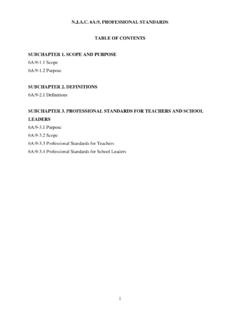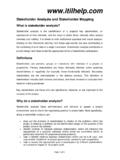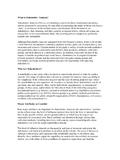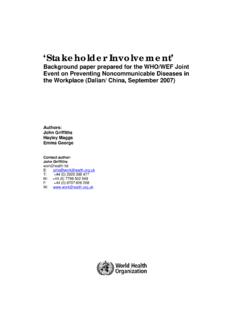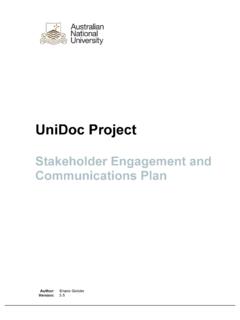Transcription of Local Stakeholder Engagement Under The Every Student ...
1 Local Stakeholder Engagement Under The Every Student Succeeds Act (ESSA): A Guide for District and School Leaders December 2017. 12/12/2017. Thank You! This guide represents the shared vision that all New Jersey students be provided with a quality education through the collective involvement of school, district, and community leaders. The information within this district guide is based on the collaborative efforts of Local partners throughout New Jersey. In particular, we would like to thank the following stakeholders: Bridgeton School District Black Horse Pike Regional High School District Cherry Hill Education Association Mainland Regional High School District Middletown Township School District New Jersey Association of Federal Program Administrators New Jersey Association of School Administrators New Jersey Educators Association New Jersey Parent Teacher Association New Jersey Principals and Supervisors Association New Jersey School Boards Association New Jersey Title I Committee of Practitioners Newark Public Schools Parent Education Organizing Council Paterson Education Fund Perth Amboy School District Roselle School District Statewide Parent Advocacy Network Vineland School District Westampton Township School District Wildwood School District Woodbridge Township School District 2.
2 12/12/2017. Table of Contents Introduction .. 4. Purpose .. 5. Meaningful Engagement in New Jersey .. 5. Developing an Annual School Plan in Collaboration with Stakeholders .. 6. Timeline for Local Planning .. 7. Funding Stakeholder Engagement .. 8. Using This Guide and Disclaimer .. 8. Section 1: ESSA Stakeholder Engagement Requirements .. 9. Required Stakeholder Groups .. 10. Section 2: Guidelines for Strategic Stakeholder Engagement .. 15. Building an Engagement Strategy Around Local Planning .. 16. Planning: Organizing Engagement .. 16. Engagement : Developing a Local Plan .. 19. Ongoing Engagement : Sustaining School Improvement .. 21. Effective Ongoing Engagement .. 22. Section 3: Effective Engagement Strategies and Tools .. 23. Effective Engagement with Identified Stakeholders .. 24. Appendices: Resources to supplement effective Stakeholder Engagement .. 31. Appendix A: NJDOE Title I School, Family and Community Involvement Resources.
3 32. Appendix B: Local and National Engagement Resources .. 33. Appendix C: Additional Stakeholders to Engage .. 37. Appendix D: Glossary of Key Stakeholder Engagement Terms .. 38. Appendix E: Stakeholder Meeting Checklist .. 42. Appendix F: Comprehensive Engagement Checklist .. 43. Appendix G: NJDOE Contacts .. 45. 3. 12/12/2017. Introduction: ESSA Stakeholder Engagement in New Jersey The following section explains the Local context of ESSA Stakeholder Engagement . Contents include: Purpose Theory of Action Using This Guide Developing an Annual School Plan in Collaboration with Stakeholders Funding Stakeholder Engagement Evidence of Stakeholder Engagement 4. 12/12/2017. Purpose The purpose of this document is to provide district and school leaders with a guide for ways to engage Local stakeholders to address the needs of students in an ongoing and meaningful way, particularly as it relates to the requirements Under ESSA.
4 Information provided in this guide is designed to align to the Annual School Planning process required for most New Jersey schools, including schools: Identified as in need of comprehensive and targeted support; or Operating a Title I schoolwide or targeted assistance program. As a support to district and school leaders, this guide sets forth federal and state Engagement requirements (Section 1) and offers strategies for consulting with diverse groups of stakeholders (Sections 2 and 3). Meaningful Engagement in New Jersey Educators, school, district and systems leaders are tasked with the extraordinary responsibility of ensuring all of their students are equally provided a high-quality education. The New Jersey Department of Education (NJDOE), in collaboration with stakeholders from across the state, considers the process of engaging stakeholders as an essential component of Student success.
5 Annually engaging stakeholders to analyze data, assess needs and identify root causes, write and implement Local plans, and monitor progress is a strong best practice to effectively improve schools. Consultation with diverse sets of stakeholders is also required Under ESSA whenever a Local education agency (LEA) receives federal Beyond Consultation: Meaningful Engagement means: representation of all Stakeholder groups in the process of developing and implementing Local plans for improving outcomes for students. In New Jersey, meaningful Engagement , beyond mere consultation, drove a more sustainable and representative ESSA State Plan development process. Therefore, the NJDOE encourages schools and districts to integrate meaningful Engagement in their annual planning process. Recommended strategies were developed by stakeholders and NJDOE staff members who collaborated to develop the ESSA State Plan and informed by successful experiences from school districts in New Jersey and across the country.
6 These experiences show that when district, school and systems leaders approach Stakeholder Engagement as a mandated, superficial process, they are less likely to achieve their goals. However, when leaders encourage and invite stakeholders who are integrated in the Local community to contribute to policy decisions about schools, students are more likely to be supported and achieve success. 1 Section 1112 (a)(1)(A); For several funding sources, ESSA includes and expands upon previous Stakeholder Engagement activities that were previously required Under No Child Left Behind (NCLB). (ESSA replaces NCLB in reauthorizing the Elementary and Secondary Education Act (ESEA) of 1965 - meant to ensure that all students have equitable access to high-quality educational opportunities. 12/12/2017. Developing an Annual School Plan in Collaboration with Stakeholders The NJDOE encourages Engagement that is strategically integrated into a district's school-level planning process.)
7 The New Jersey Annual School Planning Process2 (Figure 1) serves as a framework for long-term, sustained improvement, aligns to LEA's3 annual plans, and illustrates a model of continuous school improvement that engages stakeholders, including families, staff and community members, at Every step in a transparent and responsive way. Figure 1: New Jersey Annual School Planning Process How school-level teams can engage stakeholders at each step of the process: Data Analysis: The first step is analyzing both quantitative as well as qualitative data from the current and previous school year with stakeholders. Needs Assessment: Work closely with stakeholders to review previous and current practices and identify areas of strength, as well as areas in need of improvement and narrow the focus to three to four primary areas of focus. Root Cause Analysis: Leverage stakeholders to look below surface causes and focus on the sources that contribute to the areas of need.
8 Annual School Plan: Seek input to create the plan, set three to four SMART goals to be the focus for the entire school year, and establish checkpoints for monitoring progress. Progress Monitoring: Inform stakeholders of progress at established checkpoints and engaging stakeholders along the way; reflect on the annual plan and school progress throughout the year. 2. In January 2018, the state's new consolidated school plan (New Jersey Annual School Planning Process) is scheduled to replace the former Title I Schoolwide Plan and the former School Improvement Plan for Focus and Priority schools. Additional information and guidance regarding the framework is forthcoming following the publication of this Stakeholder guidance. 3 Local Educational Agency (LEA) is a term used throughout ESSA and will therefore be used in this document when referencing ESSA requirements. Otherwise, the more colloquial school and district is used.
9 6. 12/12/2017. Timeline for Local Planning Throughout the year, School Performance Reports and other data can and should be shared with stakeholders to further engage and empower families, educators and students. Understanding the fluid nature of a school year, Tables 1 and 2 below demonstrates a recommended timeline aligned to the typical budget, NJDOE publically released data, and the Annual Planning Process. Conversations around data drive the New Jersey Annual School Planning Process and efforts to continually enhance and expand educational opportunities for all students. Table 1: Engagement and Examples of Available Data Annually Fall Winter Spring Summer Prior to school year, Adjust and finalize a Examine budget for the plan outreach that will plan for the upcoming upcoming school year. Re- increase Stakeholder year alongside assess the path forward once Action participation. Inform stakeholders.
10 Submit ESSA allocations are made to community and begin new annual ESEA LEA. begin developing a new plan to engage plan in EWEG or alongside stakeholders. stakeholders. Annual School Plan. School Performance Reports ESEA Funding are available online. Schools Available ESEA School Allocations are made are identified by NJDOE for Data Accountability Profiles from State to LEAs. Comprehensive or Targeted support. Table 2: NJ Annual School Planning Process Year Fall Winter Spring Summer Identify Develop Annual Year A Begin data analysis Conduct needs root School Plan assessment causes Implement Annual Progress Progress Monitor Progress Monitor Year B School Plan Monitor Identify Develop Annual Begin data analysis Conduct needs root School Plan assessment causes This timeline begins in the 2017-18 school year. However, implementation and additional assessment and planning is iterative. Depending on how schools are identified, schools and districts will need to align their planning processes to specific timelines for improvement.
